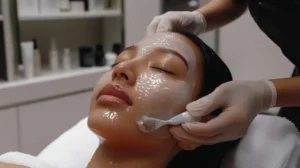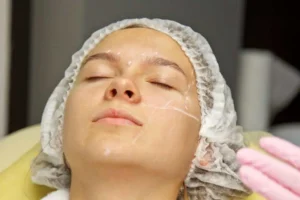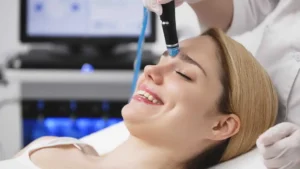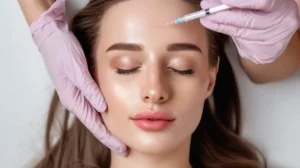Dermaplaning, a skincare procedure gaining popularity, unveils a fascinating approach to skin exfoliation that goes beyond the conventional. A treatment that leaves your skin remarkably smooth, free from unwanted peach fuzz, and ready to absorb skincare products more effectively. This might sound like a beauty secret whispered among the elite, but dermaplaning’s popularity swiftly transcends into mainstream skincare routines.
What is dermaplaning?
Dermaplaning, often referred to as a manual exfoliation technique, involves using a specialized surgical blade to gently scrape away dead skin cells and vellus hair, commonly known as “peach fuzz.” This non-invasive procedure aims to rejuvenate the skin’s appearance, resulting in a smoother texture and a brighter complexion. With its rise in popularity, dermaplaning has piqued the interest of skincare enthusiasts seeking effective exfoliation methods for a radiant, refreshed look.
Dermaplaning stands out for its ability to provide an immediate and noticeable improvement in skin texture, making it an attractive option for individuals seeking a revitalizing skincare solution. As we delve deeper, it’s crucial to explore whether this procedure suits all skin types and understand the considerations to ponder before diving into dermaplaning.
What is the dermaplaning process like?
Dermaplaning is a non-invasive cosmetic procedure designed to rejuvenate the skin’s texture and appearance. During the session, a trained skincare professional at Ella Medical Aesthetics utilizes a specialized surgical blade, held at a precise angle, to gently scrape the skin’s surface.
This meticulous technique targets the removal of dead skin cells accumulated on the epidermis, along with the fine vellus hair, commonly known as “peach fuzz.” This precise exfoliation eliminates unwanted debris, unveiling a smoother, more radiant complexion.
The procedure is conducted in a controlled environment, ensuring utmost safety and precision. Depending on the area being treated, it generally takes 30 to 45 minutes and is often combined with other skincare treatments for enhanced results.
Benefits of Dermaplaning
Dermaplaning offers several noteworthy advantages, making it an appealing choice for skincare enthusiasts seeking rejuvenation:
- Exfoliation: The primary benefit lies in its exfoliating properties. Dermaplaning unclogs pores by eliminating dead skin cells and peach fuzz, reducing the likelihood of acne breakouts, and promoting a brighter, more even skin tone.
- Enhanced Product Absorption: Following dermaplaning, skincare products penetrate more deeply and effectively into the skin. Removing the barrier of dead skin cells and fine hairs allows serums, moisturizers, and other treatments to be absorbed more readily, maximizing their efficacy.
- Smooth Skin Texture: The procedure results in a smoother skin texture, promoting a youthful appearance and a glowing complexion.
- Instant Results: One of the remarkable aspects of dermaplaning is the immediate improvement in skin texture and appearance, making it a suitable option for individuals seeking quick and noticeable results.
These benefits collectively contribute to the appeal of dermaplaning as an effective skincare treatment option.
Skin Types and Dermaplaning
Understanding your skin type is pivotal in tailoring skincare routines and treatments. While dermaplaning is generally considered safe for most skin types, it’s crucial to assess its compatibility with different skin conditions:
Oily Skin: Characterized by excessive sebum production, leading to a shiny complexion and enlarged pores. Dermaplaning can effectively remove excess oil and unclog pores, making it beneficial for managing oily skin. However, caution is advised to avoid some cases of potential irritation or exacerbation of acne.
Dry Skin: Often feels tight and rough due to a lack of moisture, potentially causing flakiness or itchiness. Dermaplaning may help eliminate dry, flaky skin, promoting a smoother texture. However, individuals with severe dryness should consider moisturizing adequately post-treatment to prevent further dryness or irritation.
Sensitive Skin: Prone to irritation, redness, or allergic reactions due to various triggers like certain products, weather conditions, or environmental factors. Those with sensitive skin might be more prone to irritation during dermaplaning. A patch test or consultation with a skincare professional is advisable to evaluate the skin’s response beforehand.
Combination Skin: Exhibits characteristics of multiple skin types, such as an oily T-zone (forehead, nose, and chin) and dryness in other areas. Dermaplaning can benefit combination skin by targeting areas prone to excess oil while smoothing dry patches. However, a personalized approach considering specific skin concerns is recommended.
Understanding your skin type and its potential reactions to dermaplaning can help determine if this procedure aligns with your skincare goals and individual needs.
Is dermaplaning suitable for your skin type?
Certain skin types can particularly benefit from dermaplaning. While dermaplaning is generally safe, some skin types may require more caution or specific considerations. Here’s how dermaplaning helps your skin type:
Dry or Flaky Skin: Dermaplaning aids in removing dead skin cells, addressing dryness, and promoting a smoother texture.
Oily or Acne-Prone Skin: Individuals with excess oil production may find dermaplaning beneficial for reducing congestion, unclogging pores, and potentially minimizing breakouts.
Dull or Uneven Skin Texture: Those seeking immediate improvement in skin texture and radiance can benefit from dermaplaning’s exfoliating effects.
Sensitive Skin: Individuals with sensitive skin might experience increased susceptibility to irritation or redness post-dermaplaning. A patch test or cautious approach is recommended.
Active Skin Conditions: Those with active acne, eczema, or sunburn should postpone dermaplaning until these conditions are resolved to prevent potential irritation or complications.
Understanding the nuances of various skin types helps determine the likelihood of favorable outcomes and guides individuals toward suitable skincare treatments.
Safety Measures and Precautions
Seeking guidance from a skincare professional before undergoing dermaplaning is crucial. A certified professional like those at Ella Medical Aesthetics possesses the expertise to assess your skin type, potential risks, and suitability for the procedure. Their evaluation ensures dermaplaning aligns with your skincare goals and helps craft a tailored treatment plan to achieve optimal results.
While dermaplaning is generally safe, it’s essential to acknowledge potential side effects and risks:
- Temporary Redness: Mild redness might occur post-treatment, subsiding within a day or two.
- Risk of Irritation: Individuals with sensitive skin might experience slight irritation or inflammation.
- Infection Risk: Improper tools or unsterilized equipment could lead to infection. Therefore, ensuring a sterile environment is crucial.
- Unwanted Outcomes: Inexperienced practitioners or incorrect techniques might cause nicks, cuts, or uneven results.
Adherence to proper hygiene practices and relying on trained professionals significantly mitigate these risks.
Pre-Treatment Considerations
Before opting for dermaplaning, several pre-treatment considerations based on skin type should be contemplated:
- Skin Sensitivity: Individuals with highly sensitive or reactive skin might require a patch test to assess skin response beforehand.
- Skin Conditions: Those with active acne, eczema, or sunburn should delay dermaplaning until these conditions subside to prevent exacerbation.
- Skincare Products: Discontinuing certain exfoliating products or treatments a few days before dermaplaning can prevent excessive skin irritation.
Understanding these pre-treatment considerations assists in preparing the skin and ensuring a safer and more effective dermaplaning experience.
Conclusion
Dermaplaning, a promising skincare procedure, offers numerous benefits but necessitates careful consideration for different skin types. Understanding these safety measures is paramount:
- Dermaplaning is generally safe for various skin types but may pose slight risks, such as temporary redness or irritation, especially for sensitive skin.
- Prior professional consultation and evaluation are crucial to ascertain if dermaplaning aligns with individual skin concerns and goals.
- Adhering to pre-treatment precautions and choosing certified professionals significantly enhances safety.
Making informed decisions about skincare treatments, particularly dermaplaning, involves seeking guidance from skincare experts. Professionals can assess skin types, discuss potential risks, and provide personalized recommendations tailored to individual needs. Your skin’s unique characteristics and conditions should guide your choices.
Ella Medical Aesthetics is committed to ensuring your skincare journey is safe, effective, and personalized. We encourage you to schedule a consultation with our experienced skincare professionals. Our team will provide customized advice, address your concerns, and guide you through suitable skincare treatments, including dermaplaning, to achieve your desired results.








